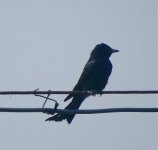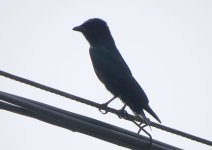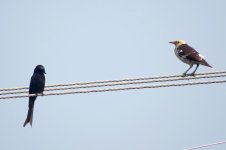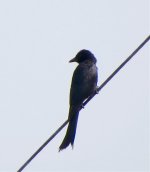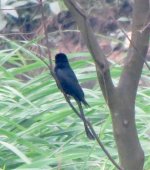Hi all,
I've just started to notice drongos in our area (Nanchang, Jiangxi), and am trying to figure out what they are. Yesterday, I'm fairly sure I saw (but have no picture of) a grey morph Ashy Drongo. I'm having troubles identifying the others, though I thought that I had gotten more familiar with the Hair-crested while in Thailand. In particular, I haven't found pictures of all of them flying and so haven't really figured out their flight shape.
These pictures are all taken in the last few weeks. This group, doesn't have any that look like Hair-crested to me, but I'm not very sure how to distinguish dark Ashy and Black Drongos. It may be that these pictures are not clear enough, or from the right angle, to show the necessary features (e.g. eye color or white spot near beak) ... black birds are about as tough as white ones to get exposed well! Also, the 2nd pic is of either a young bird, or one that lost its tail I guess. Any thoughts on that one?
Thanks!
I've just started to notice drongos in our area (Nanchang, Jiangxi), and am trying to figure out what they are. Yesterday, I'm fairly sure I saw (but have no picture of) a grey morph Ashy Drongo. I'm having troubles identifying the others, though I thought that I had gotten more familiar with the Hair-crested while in Thailand. In particular, I haven't found pictures of all of them flying and so haven't really figured out their flight shape.
These pictures are all taken in the last few weeks. This group, doesn't have any that look like Hair-crested to me, but I'm not very sure how to distinguish dark Ashy and Black Drongos. It may be that these pictures are not clear enough, or from the right angle, to show the necessary features (e.g. eye color or white spot near beak) ... black birds are about as tough as white ones to get exposed well! Also, the 2nd pic is of either a young bird, or one that lost its tail I guess. Any thoughts on that one?
Thanks!




